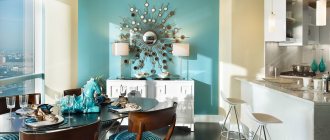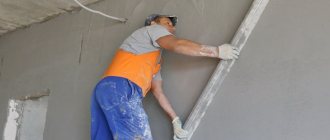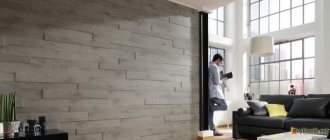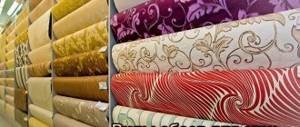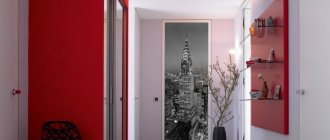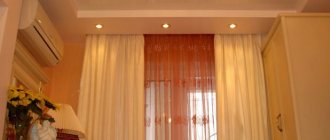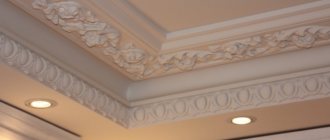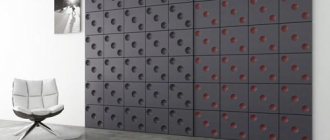What is the best paint for walls in an apartment? Read about it further, and also see unique photos of the interiors!
Painting walls in an apartment is becoming popular again today, since many high-quality paints have appeared on the market, characterized by durability, durability and better decorative properties. With their help, you can create amazing interior design in both modern and classic styles. In addition, painting walls and ceilings is much easier than gluing wallpaper (read our article “Wallpaper or painting walls: which is better?”). Just imagine how your task will be simplified when to finish problem areas - arches, joints, etc. - it will be enough to go over it several times with a brush or roller!
Good paint for walls in an apartment: options and tips for choosing
The range of modern paints is so wide that the question “how to choose paint for walls and ceilings in an apartment?” is quite natural. Let's look at the most popular types of paints, with their advantages and disadvantages.
This year, water-based paint for walls and ceilings is considered the real queen of the market. Advantages of water-based paint:
- easy to apply;
- dries quickly;
- has no smell;
- penetrates deeply into the surface;
- has elasticity and resistance to cracking;
- retains color over time without yellowing;
- does not emit toxic elements.
With all this, it also has some disadvantages that are directly related to the process of applying it to the walls. Thus, painting an apartment with water-based emulsion requires careful preparation of the surface, otherwise the slightest imperfections will be visible on it.
Note that water-based wall paint also has its own varieties, the most popular of which are acrylic and silicone paints.
How to prepare walls
The preparation stage is not very easy. But we can’t do without it. First of all, clear the room of extraneous furniture so that nothing disturbs you. Before painting, take care to protect the floor by covering it with film.
It is not possible to hide wall unevenness by painting, so you will need to get rid of them before work. Remove any remaining plaster and level the surface using putty.
The type of putty and primer is selected depending on the indicators. For example, for a room with a high moisture level, manufacturers produce separate materials. We recommend pre-treating the wall with a penetrating primer; this will significantly reduce the consumption of paint and varnish products and strengthen the base of the wall.
Decorative paint can be applied only after the previous solutions have completely dried. The wall must be dry and smooth.
Although preparing the wall takes a fairly long period of time, this process cannot be neglected.
Acrylic water-based paint for walls and ceilings
Acrylic paint combines the waterproof properties of water-based paints with the superior durability of oil-based paints. It easily sticks to all surfaces (of course, if they have been well primed): wood, plastic, metal and even brickwork. High elasticity allows it to stretch and shrink without cracking. Other benefits of acrylic paints include:
- do not swell from moisture and resist the formation of mold;
- are not afraid of sunlight, retain shine for a long time and have color fastness;
- dry quickly (within a couple of hours);
- have almost no odor.
At the same time, acrylic paint for walls and ceilings has a number of disadvantages. Firstly, it is not highly fluid and when applied, strokes may be visible. To reduce this effect, additional conditioners and enamels are added to the paint composition. Secondly, this paint also requires careful surface preparation and cannot be applied over old paint. Finally, high-quality acrylic paints are quite expensive, although their durability and durability fully justify this price.
Also read: How to buy good windows - photos, design, characteristics
Technologies for material preparation and application
Having understood the types of paint, let's look at how to properly apply them to walls. Both quality and appearance will depend on proper preparation.
Tinting of the composition
Water-based paints are sold either in white or in a limited range of colors. The main variety of shades is achieved through tinting - the process of adding colored pigment to white paint. These additives are produced by the same companies and can be combined with each other to obtain the desired shades. Full compatibility of materials is guaranteed only by the joint use of products from the same brand.
We recommend: Types of parquet tinting with oil and varnish
Tint card
Tinting can be done independently, or using a special computer-controlled installation. The second preparation option is not cheap, but the system itself will do the pigment dosage, thoroughly mix and produce the finished product of the same tone. This approach should be used when large areas need to be painted, and one bucket of paint will not be enough.
For small amounts of work, you can arm yourself with a mixer and do everything yourself, achieving the desired shade. At the same time, remember that the paint in liquid and frozen form will differ in shade saturation. Most often it becomes lighter after drying, although there are exceptions. Therefore, do not rush to pour in all the color and before painting the walls, do a test paint on a piece of the same drywall, let it dry, and only then check the shade.
We will also give you some practical advice: mix the entire volume of paint with the color. It is not worth dividing into portions for the reasons already stated. It’s better to apply one extra layer or get a remainder that may still be useful, than not have enough paint for 1 square and then have to repaint everything again.
Paint tinting process - mixing is done with an electric drill
Of course, we cannot decide for a person what color to use, but we will give a couple of recommendations for its selection. Perhaps they will be useful to someone:
- Light walls in a room will visually increase its volume, while dark walls will do the opposite. Use this principle when selecting paint to create the desired effect.
- Match the tones of the ceiling and walls. If the first one is darker (with good contrast), the room will appear squat. If it is lighter, there will be a feeling of greater height.
- For bedrooms it is better to choose light, dim matte walls - beige, gray, blue, green. They will create comfort and will not once again disturb a person’s consciousness. For the active zone, on the contrary, rich and bright shades are suitable - orange, red in moderate quantities, yellow, azure. In the office or hallway, you can take something darker, which is dictated by the need to concentrate and the practical side of the issue.
- You should not use more than three primary shades in one room, otherwise it will create the impression of a color mishmash. It’s also not worth making everything monochromatic. Select the main area in the room to which you want to attract the viewer’s attention, using the laws of contrasts and color combinations. An example of this approach is shown in the following photograph.
What colors are used to paint the walls in the apartment - a combination of shades
Preparing the base
Before tinting the paint, you must carefully prepare the surfaces to be painted. In this chapter we will look at how to do this correctly.
- The finished wall should be smooth, level and clean. If there is old putty and plaster on it, check its condition for strength. Using a sharp spatula, go over the entire wall. Where delamination is found, the rough finishing materials are sanded down to areas with good adhesion.
- New walls are preliminarily plastered over the beacons, after which they are puttied in several thin layers until the surface of the required quality is obtained.
- If there is old whitewash on the walls, and it is cracked in places, you need to either remove it completely, or clean the problem areas, which are then smoothed out with putty. New paint will not adhere well if the old one is of a different type. Chalk whitewash is washed off from the surface with water. The limescale is cleaned off mechanically after it has been thoroughly wetted. Water-based paints can also be removed with a spatula after preliminary impregnation, but with hot water or deep penetration acrylic primer. Paints based on organic solvents are removed with special removers, when heated with a hairdryer or with a hammer drill, together with the plaster.
- A better quality surface is obtained when it is completely puttied. For partial repairs, it is necessary to smooth out the edges - cracks may appear in these places over time. Therefore, whenever possible, we process the entire wall.
- When putting putty on the walls, it is necessary to smooth out the unevenness visible to the eye and fill in the depressions and cracks. During work, you need to organize oblique illumination of the surface to detect problem areas.
We recommend: Restoring block parquet by sanding
Cracks in the plaster appeared due to too rapid removal of moisture from the composition
- The wall should be examined for cracks. If this is obvious damage from deformation of the house frame, preliminary repairs and sealing are carried out. To do this, the crack is expanded to the depth of the plaster, and thorough cleaning of dust and priming is carried out. Next, reinforcement is installed - depending on the degree of damage, fiberglass mesh, special paper, metal mesh and even steel staples can be used. Then everything is sealed with a repair compound, and the surface is puttied.
- If the cracks are like in the photo above, there is no need to repair them, since they appeared because the wall was poorly primed before plastering, and moisture from the mixture was quickly absorbed into it. Here you will have to putty 1-2 more layers than would be required for a high-quality wall.
- The final stage is grinding the surface. Abrasive treatment will make the walls as smooth as possible. For this work, hand and electric tools are used.
Sanding the wall
Do I need to prime the wall before painting? A difficult question to which there is no clear answer. In theory, this process is necessary, but...
- You need to use the same type of primer as the paint, otherwise it will only make things worse. Adhesion will decrease and the paint will apply unevenly.
- When applying primer, drips form. Visible marks remain in these places, and the wall itself absorbs water more slowly. As a result, after applying the paint, these marks will remain noticeable. Applying several layers does not help either.
If the surface is prepared correctly and the putty adheres securely, it is better to paint directly over it, after only cleaning it first.
Painting the walls
To work you will need a simple set of tools:
- Roller with medium length pile;
- Ditch for convenient dipping of the tool into paint;
- Small jar;
- Brush for painting hard-to-reach places;
- A hammer drill, electric drill or screwdriver combined with a mixer attachment when tinting is required manually.
Painter's tool
- Open the bucket of paint and check its thickness. If the composition seems thick to you, stir it with water, adding no more than 5% of the liquid from the total mass. Paint that is too thick will result in increased consumption.
Advice! Mixing of the paint is always carried out, since during its storage the substances in the composition separate, and it is necessary to make the mixture homogeneous.
Then we start painting - nothing complicated, but there are tricks:
- Drywall should be painted no earlier than 2 weeks from the moment the joints are puttied, since due to incomplete hydration in thick layers of gypsum, the surface may be painted unevenly.
- The work starts with painting the corners, for which a brush is used. You need to paint to a width of 4-5 cm, so that you can then reach the border with a roller.
- The roller is dipped into the tray, after which it rolls out on it. This is not done on the wall, as the coating will be uneven.
- Painting one layer of one surface is done without interruptions, otherwise when it dries, a border will form that will be noticeable.
- Carefully monitor the absence of drips and quickly roll them out.
- The first coat must dry for at least 1 hour before the second coat can be applied.
- Each subsequent layer is applied perpendicular to the previous one - this allows you to get rid of streaks.
- The last layer should be directed parallel to the rays of light falling from the window onto the walls. This way, the flaws that always exist will remain invisible.
Silicone paint for painting walls in an apartment
Another popular type of water-based paint. Due to the silicone content, it is ideal for application in places of high humidity, for example, in the bathroom or kitchen. Its main advantages over other water-based paints are vapor permeability and the ability to hide minor wall imperfections, such as cracks and scratches ranging in size from 1 to 3 mm. But good quality comes at a price: silicone paints are among the most expensive on the market.
Features of latex paint for walls and ceilings
Latex paints are remarkable because they are very easy to care for. It is enough to wash the walls and ceiling occasionally with ordinary soap and water. Like all water-based paints, they retain color for a long time and resist the formation of mold. Acrylic is usually used as a binder, which gives the coating special strength and flexibility. In addition, latex paint for walls and ceilings in an apartment does not become brittle over time, does not peel or swell.
Original decorative paint for walls in an apartment
Under decorative paint, both simple matte and glossy paints, and special compositions with unusual textures can be perceived. Today, decorative paint for walls has more than 20,000 interesting colors and textures - just imagine what possibilities it opens up for the design of your apartment!
Among the most popular and fashionable new products for 2020: decorative paint with magnetic properties, with a chalkboard effect, with imitation of stones and metals, with fluorescent properties and much more. etc.
Also read: Modern trends - bright wall colors in the interior
Painting walls in an apartment - a selection of 27 photo examples
Are you interested in stylish, modern options for painting walls in your apartment? Here we have collected 27 photos of interiors with painted walls and ceilings. Let's enjoy the beautiful design!
Also read: 30 green kitchen design ideas
Also read: Beyond fashion and time - blue color in the interior
Why paint
The two most popular options for indoor wall decoration are wallpaper and paint. And each of them will be preferable in different situations, if you do not take into account the potential desires of the owners.
Joke of the day: how to paint walls - with a roller and paint...
This chapter will turn into a listing of the advantages of paint, as the hero of today's review:
- Water-based paints of the modern generation have a long service life. Washable options last much longer than paper wallpaper.
- The technology for applying the material is extremely simple and accessible to anyone. Speed is also important - you can paint a room in just a couple of hours.
- If the same shade of paint is present, damage to the walls can be easily restored, taking on its previous appearance.
Attention! It’s worth stopping here, since this advantage is very controversial. This is only true as long as you have paint of the same shade, that is, tinted at the time of painting. The shelf life of water-based compositions is unlikely to exceed one year, and it is difficult to obtain exactly the same shade even with special equipment, and completely unrealistic by hand. Therefore, the renovated place will stand out. In such a situation, you will have to repaint the entire wall, or even the room.
- Water-dispersion paints have good hiding power and are available in a wide range of colors. This allows you to change the appearance of the entire room in the shortest possible time.
- Even the most expensive paint will be much cheaper than good wallpaper, which is what many users like.
- The paint is also good for finishing plaster and plasterboard ceilings. Wallpaper is also glued to the ceiling, but much less often.
Bright sun overhead is not a problem
Where would we be without a fly in the ointment? Like any other material, paints have their drawbacks:
- It is necessary to prepare the surface more thoroughly for paint - if two layers of putty are enough for wallpaper, then 3-4 may be required here. The presence of defects is unacceptable, as paint will only highlight them. The exception is structural paints, which leave a pattern on the walls. For them, the presence of small differences is not a problem.
- Painted walls remain cold and unpleasant to touch with your skin. The question is especially relevant for hallways...
- A room with painted walls has a stronger echo. If there is little furniture placed, it will be much more difficult to achieve a feeling of comfort.
Requirements for modern paints
What paint to paint the walls in the apartment - it should be resistant to damage
To get all the listed benefits from paint, you need to pay attention to its composition and the main characteristics that the composition has:
- Resistance to dry abrasion - when contacting the surface with body parts or clothing, no visible marks should remain. This is the key to not only comfortable use, but also the durability of the coating.
- No toxic odor - it is highly undesirable to use compositions based on organic solvents inside residential premises. A person has to breathe in fumes not only at the time of application, but also for several days while all the chemical processes take place in the paint.
- Quick drying - the faster the paint dries, the faster new layers can be applied, and the sooner the renovation in the apartment will be completed.
Advice! Good water-dispersion paint becomes touch-dry within 1-2 hours. Its complete polymerization occurs within 24 hours
- For rooms with high humidity (bathroom, kitchen), moisture- and vapor-proof paint should be used, which can protect the walls and ceilings from regular wetting. This paint will have a uniform shade even with regular splashes.
We recommend: How to properly prepare a floor for pouring
Well, I would like good paint to not be too expensive. Of course, everything good costs money, but there is always a reasonable combination of price and quality.
Paints for painting walls in an apartment
In this chapter, we will analyze separately the compositions that are relevant today. There are not many of them, so you can easily keep all the information in your head when purchasing.
| Type of paint, photo: | Description: |
| Acrylic paint | The most common option is acrylic paint. It is presented in the form of the same aqueous dispersion, which is easily diluted, tinted and applied to the walls. The composition has good resistance to dry abrasion. It is not able to retain moisture, so it should be used for dry rooms. Technically, the surface can be wiped off from small stains with a damp cloth, but the paint cannot be called washable, since if there is an abundance of water, both the color and the integrity of the coating itself will suffer. When in contact with clothing, it does not leave marks on it. Not able to hide cracks and unevenness on the base. |
| Silicone paint | This composition is fully washable. Upon completion of polymerization, a waterproof elastic film is formed on the surface. Its surface is resistant to tensile and abrasive loads. When small cracks appear at the base, it can stretch a little without being damaged, which is very good for recently built houses, where shrinkage processes may still continue. Interesting to know! High-quality silicone paint can withstand up to 5,000 wet cleanings. Its service life is long, the cost will be around 2500 rubles for 15 liters. See the label for consumption and other parameters. |
| What is the best paint to paint the walls in an apartment - rubber paint | Another coating option that is resistant to water, steam and wet cleaning. The basis of the material is acrylic latex, which, when hardened, also becomes an elastic film, insoluble in water. Like other compositions, it can be tinted. Has a long service life. Can be used as an additional vapor barrier for ceilings and walls. |
It is clear that not all formulations are equally good, as evidenced by the pricing of similar products from different manufacturers. The compositions from famous world brands are traditionally distinguished by their high quality. If you are not limited by budget, feel free to buy paints from Tikkurila, Dulux, Beckers and others. If you follow the painting technology, the high quality of the coating will be guaranteed for many years.
What paint to paint the walls if you don’t want to spend money? Pay attention to products from domestic manufacturers and the middle segment. We do not recommend buying frankly cheap formulations. Among others, brands such as Tex, Lakra, Kazachka, Expert, Diola and others stand out.
Interesting to know! Inexpensive products Tex is a brand owned by the Finnish Tikkurila. At a modest price, the paint has decent quality, which is confirmed not only by advertising, but also by reviews of real users. If desired, search for information on the Internet.
The listed paints, depending on the variation in composition, can produce matte and glossy surfaces. The latter are more demanding on the evenness of the base, so when choosing a bright gloss, carefully prepare the surfaces for painting.
